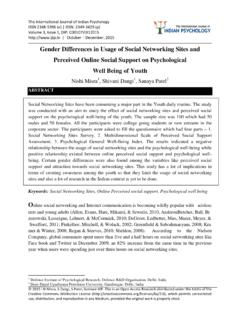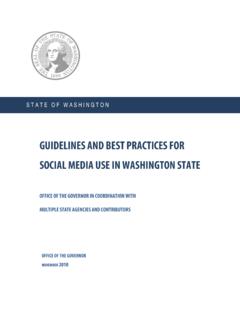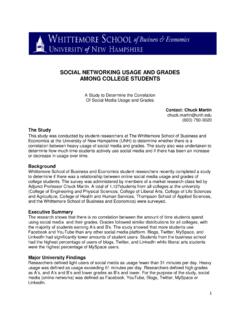Transcription of Quantifying Suicidal Ideation via Language Usage on Social ...
1 Quantifying Suicidal Ideation via Language Usage on Social MediaGlen is a large and growing problem, yet relevant data to draw informed decisions and assessintervention strategies is sorely lacking, and often at least two years out of date. We analyze publiclyavailable data to assess the viability of using it to provide more timely information. We examinequantifiable signals related to suicide attempts and Suicidal Ideation in the Language of Social mediadata. Our data consists of Twitter users who have attempted suicide and age- and gender-matchedneurotypical controls and similarly matched clinically depressed users.
2 We apply simple languagemodeling techniques to separate those users automatically, and examine what quantifiable signalsallow them to function, tying them back to psychometrically validated concepts related to then use these scalable classifiers with public Social media data and open government data tosuggest some direction for future epidemiological research. All this research is done with publicdata, though we take great care to protect the privacy of the Words:Mental Health, Social media , Suicidal Ideation , Suicide1. IntroductionSuicide is a large and growing problem worldwide, but data to inform decisions is decidedlacking.
3 When data is available, it is often significantly delayed. Suicide is the secondleading cause of death for teenagers and the leading cause of death for women ages 15-19worldwide [World Health Organization et al., 2014], and among the top ten leading causesof death in the United States [Sullivan et al., 2013]. Certain groups are particularly atrisk, with veterans having an elevated risk compared to the civilian population [Blow et al.,2012]. Moreover, the rates of suicides seem to be growing, with an increase of 28% in thecivilian population of the United States between 1999 and 2010, with some groups notablyhigher than that ( , whites increased 40% and Native Americans 65%) [Sullivan et al.]
4 ,2013].While approximately 1% of people die by suicide, an estimated attempt suicide, make plans for suicide and think about ending their own life, termedsuicidalideation[Nock et al., 2008]. Ultimately we seek ways to prevent suicides, but a betterunderstanding of the underlying phenomenon is required to facilitate the design of andevaluation of effective interventions. This data is difficult to obtain, and when available itis typically delayed by at least two years for example consider the BRFSS [Centers forDisease Control and Prevention (CDC), 2010]. Public and health policy decisions needhigher quality population-level data in a more reasonble timeframe to be able to adequatelyplan and adjust responses.
5 At the individual patient level, mental health professionals seek-ing to identify those at risk of suicide could benefit from a better understanding of suicidalideation and intervention strategies augmented by automatic means to identify it. Interven-tion immediately prior to a suicide attempt ( , means restriction) is time consuming andcostly. Earlier intervention aimed at the underlying causes of suicide could significantlyscale the ability of mental healthcare professionals to help those at risk of , we find and examine quantifiable signals related to suicide attempts and suici-dal Ideation in the Language of Social media data.
6 Introspection on those quantifiable signalsprovides some insight as to how they work and how they might connect to known psycho-logical phenomena related to Suicidal Ideation . We then go on to demonstrate what is madepossible by scalable quantifiable measures of mental health, such as these classifiers, andinsight they can provide us at both and individual and population Social media ? Social media mayprima facieseem like a strange choice to seekmental health signals, but upon closer inspection, it seems to be the digital version ofmore venerable, well-established methods. Having patients or their relatives keep jour-nals of mood, thoughts, feelings, and occurrences has been a frequently-used techniquein psychology research.
7 These journals were often manually transcribed and codified byresearchers or clinicians to get quantifiable information regarding the hypotheses studied a time-consuming and expensive type of study to undertake, often yielding only tens ofsubjects. Social media , however, is providing the raw materials for the largest journalingstudy to date, with tens of millions of users with publicly available media may be more useful for the study of mental health than journaling-typestudies of yester-year. Physical health ailments can often be easily measured in a doctor soffice or emergency room, but the equivalent mental health ailments are more difficult toassess, because many of the effective causes and symptoms relate to the patient s interac-tion with the rest of the world almost by definition everything that happensoutsideofinteraction with traditional healthcare professionals.
8 Furthermore, data gathered via socialmedia is already in digitized form, making it conducive to automated analysis. Lookingforward, it also provides the technical means to interact with users. This opens up inter-esting avenues for scalable interventions ( , connecting a Suicidal person to resources orpeer support), but striking the balance between privacy and intervention will not be technology can support such interventions, it appears that the general population isnot amenable to such interventions at the expense of privacy. Despite the potential for livessaved, the recent events surrounding the Samaritan s Radar App1are a cautionary Health and Social MediaThere has been an explosion of recent work exam-ining mental health signals through Social media .
9 Most of the work has focused on per-vasive mental health concerns and psychological states, for example detecting depres-sion [Schwartz et al., 2014, Resnik et al., 2013, De Choudhury et al., 2013a, De Choudhuryet al., 2013b, Rosenquist et al., 2010, Ramirez-Esparza et al., 2008, Chung and Pennebaker,2007], examining personality factors [Schwartz et al., 2013b,Park et al., 2015], or assessingpsychological well-being [Schwartz et al., 2013a].Alternate methods for obtaining data related to mental health conditions were intro-duced by Coppersmith et al., which widened the aperture of possible conditions to inves-tigate [Coppersmith et al.]
10 , 2015a, Coppersmith et al., 2014a, Coppersmith et al., 2014b].These techniques enabled analysis of rarer conditions like schizophrenia [Mitchell et al.,2015], which affects an estimated 1% of the population of the United States [The NationalInstitute of Mental Health, 2015]. Those rates are roughly equivalent to the suicide rate,and many times smaller than the estimated rate of Suicidal Ideation [Nock et al., 2008].Suicide and Suicidal Ideation has been less well studied via Social media . There hasbeen some analysis of a suicide support forum and how the Werther or Papageno effectsmight be quantified using this data [Kumar et al.









